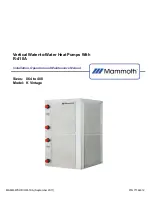
6
MAMM-WSHP-IOM-1KA (September 2011)
Unit Piping
1. All K-Vintage heat pumps should be connected to
supply and return piping in a two-pipe reverse
return configuration. A reverse return system is
inherently self-balancing and requires only trim
balancing where multiple quantities of heat pumps
with different flow and pressure drop characteristics
exist in the same loop. Check for proper water
balance by measuring differential temperature
reading across the water connections. To verify
proper water flow, the differential temperature
should be between 7°F to 10°F for heat pumps in
the cooling mode or heating mode.
2. The piping may be steel, copper, or PVC. Avoid
dissimilar metal fittings as they may corrode. If the
use of dissimilar metals is unavoidable, use
dielectric isolation at that connection point. We
recommend a 30 mesh strainer (supplied by
others) be mounted prior to the water inlet to the
unit.
3. Supply and return run-outs usually join the heat
pump via short lengths of flexible hose which that
can be sound attenuators for hydraulic pumping
noise.
Make sure hoses and pipes are suitable for
system water pressure and sized for proper flow
rate. Never use flexible hoses that are smaller
(inside diameter) than that of the water connection
on the unit.
One end of the hose should have a
swivel fitting to facilitate removal for service. Hard
piping can also be brought directly to the heat
pump. This option is not recommended since no
vibration or noise attenuation can be accomplished.
The hard piping must have a union to facilitate heat
pump removal.
4.
The supply and the discharge pipes should be
insulated to prevent condensation damage caused
by low water temperature in the pipes.
5. Make sure that threaded fittings are sealed. Teflon
tape can be used to provide a tight seal.
6. Supply and return shutoff valves are required at
each heat pump.
All flow valves should be ball
type.
The return valve is used for balancing and
should have a “memory stop” so that it can always
be closed off but can only be reopened to the
proper position for the flow required.
To avoid
water hammer during start-up or shut down,
solenoid vales of the slow closing diaphragm type
should be used. Placing the solenoid valve on the
outlet side of the system helps relieve this situation.
Due to high pressure drop or poor throttling
characteristics, globe and gate valves should not
be used.
7. No heat pump should be connected to the supply
and return piping until the water system has been
cleaned and flushed completely. After the cleaning
and flushing has taken place, the initial connection
should have all valves wide open in preparation for
the water system flushing.
Содержание K Vintage
Страница 18: ...18 MAMM WSHP IOM 1KA September 2011 Notes ...
Страница 19: ...19 MAMM WSHP IOM 1KA September 2011 Notes ...






































